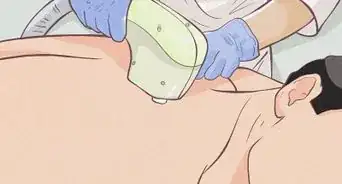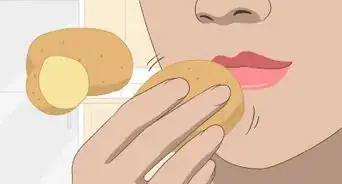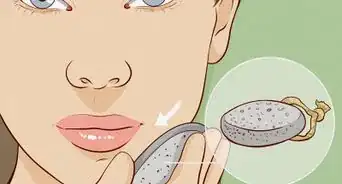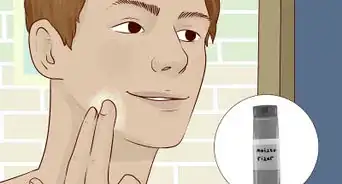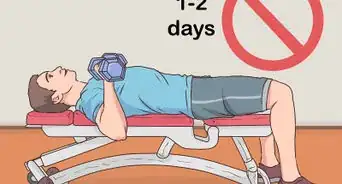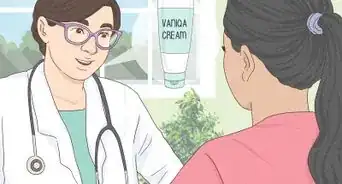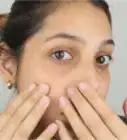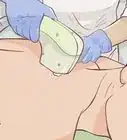This article was co-authored by Melissa Jannes. Melissa Jannes is a Licensed Esthetician and the owner of Maebee's Beauty Studio in Philadelphia, a single practitioner space providing quality services with individualized attention. Melissa is also a National Educator for Universal Companies. She received her esthetics degree at The Beauty School of Middletown in 2008 and is licensed in both New York and Pennsylvania. Melissa won the "Best of Beauty" award from Allure magazine in 2012 for the quality of her bikini waxing.
There are 8 references cited in this article, which can be found at the bottom of the page.
wikiHow marks an article as reader-approved once it receives enough positive feedback. In this case, several readers have written to tell us that this article was helpful to them, earning it our reader-approved status.
This article has been viewed 2,917,802 times.
Whether it's a few dark strands or a full-fledged mustache, upper lip hair can feel like an unsightly embarrassment for many girls who have it. If you want to remove your mustache, skip the shaving and opt for longer-lasting methods like waxing, depilatory cream, electrolysis, or laser removal. You can also minimize the appearance of upper lip hair by bleaching it.
Steps
Using Depilatory Cream
-
1Choose a depilatory cream for a painless option. Depilatory creams dissolve the hair at the surface of your skin. If used correctly, these creams are painless, so choose this method if you want to avoid the pain caused by waxing or epilators.
- Hair removal creams will dissolve the hair where it meets the skin, and the result will be comparable to shaving.[1]
-
2Find a depilatory cream that is appropriate for facial hair. Because the chemicals involved in this process are harsh, select a cream designed for delicate facial skin. Visit a beauty supply store, and search for a product that specifically states it’s for facial hair. If you’re unsure, ask an associate to point one out for you.Advertisement
-
3Spot-test the cream. Apply a small dab to a sensitive but safe area (such as the skin of your inner wrist) to make sure your skin doesn’t react. Leave it on for the recommended amount of time, which will likely be around five minutes, and then wash it away thoroughly. Wait at least another 10 or 15 minutes to make sure your skin doesn’t begin to itch or turn red.
-
4Spread a thick coat of the paste over your upper lip. Put on disposable gloves and squeeze a pea-sized amount onto your finger. Start directly under your nose and wipe out in both directions across your upper lip. Make sure there’s a thick coat of the product covering the entire area.
- If you wipe the product too far out and it reaches your cheek, immediately wipe it off that area with a damp cloth.
- If your product came with a small spatula, you can also use that to apply the cream.
-
5Leave the cream on for three to six minutes. Follow the instructions on the product carefully. They will likely tell you to let the cream sit on your skin for three to six minutes, but it’s better to err on the side of less time if it’s your first application. If you begin to feel a tingle on your upper lip, wipe the product away immediately.[2]
-
6Rub a small section of skin to see if hair comes off. Using your fingertip or a Q-tip, gently rub a tiny portion of your upper lip to see if the hair wipes away. If so, go ahead and remove the cream. If not, wait until you’ve reached the maximum amount of application time.
- Never leave the product on for longer than the recommended amount of time. Your skin can get irritated or burned.
-
7Wipe away the cream using a damp cloth. Use a damp cloth or paper towel to wipe the cream off your skin. You can also get in the shower and simply rub the cream off with your fingers.
-
8Rinse your skin thoroughly with soap and water. Lather your fingers with soap and water and then gently rub your upper lip to remove any of the product residue. Then rub or splash water on your upper lip to give it a final rinse.
-
9Apply a gentle cream afterwards. If the area feels dry after this process, apply a gentle, fragrance-free moisturizing cream or lotion. Reapply the cream or lotion as needed over the next day or two.
-
10Repeat this process every three to five days. Depilatory creams are only a temporary solution, and the hair will grow back in three to five days. You can use the product again after three days, but stop using it if you get irritated, itchy, or red skin.
Waxing Your Mustache
-
1Choose waxing if you want a longer-lasting solution. Waxing removes the hair from the root, and can give you two or more weeks of hairlessness. It can be painful, however, so visit a beauty salon to have it done for you if you don’t think you can do it yourself.
-
2Wait until hair has grown to a quarter of an inch (0.6 cm). Waxing is only effective if the wax can stick to the hairs, so wait until the hairs on your upper lip have grown to a quarter of an inch (0.6 cm). If you aren’t willing to let your hairs grow long enough to do this, use another method, such as bleaching.
-
3Find a wax that is appropriate for facial hair. Visit a beauty supply store or drugstore and purchase a home waxing kit. Make sure it specifically states it can be used on facial hair. You can either get spreadable wax or ready-made strips that already have wax applied. The ready-made strips are the tidier option, though they are sometimes less effective.[3]
-
4Wash your face with an exfoliating cleanser to minimize pain. Cleaning out your pores and removing built-up dead skin cells will make it easier for the wax to pull the hair from the follicle. Scrub your face with an exfoliating wash, or use a normal face wash and scrub with a washcloth.
- Other ways to minimize pain include applying numbing creams, taking a hot shower beforehand, and avoiding caffeine and alcohol on waxing day.
-
5Heat up the wax in the microwave if necessary. Most waxes must be warmed up, but wax strips are sometimes the exception. Place the container of wax in the microwave and heat it for the recommended amount of time. Follow the instructions on your product carefully to avoid overheating it and burning yourself.
-
6Apply spreadable wax over the mustache area. If you purchased spreadable wax, use the applicator that came with the kit to spread it carefully along your upper lip. Apply it in the same direction that the hair grows. The wax should cover your mustache area in a thick layer, but be sure to avoid the delicate skin on your lips and in your nose.[4]
-
7Apply a waxing strip over your upper lip. Whether you just spread wax over your upper lip, or you purchased strips with wax already on them, apply a strip across your mustache area. Start on one side of your upper lip and move across the middle as you apply it. Pull it taut as you smooth it over the area with your fingers, making sure no air bubbles get trapped under the strip.
-
8Wait the recommended time. Follow the product instructions for how long you should leave the wax on. Removing it too early may render it ineffective, and waiting too long is unlikely to make it more effective.
-
9Tear off the strip in one quick motion. Hold the skin next to your upper lip taut with one hand, and grasp one end of the strip with the other. Yank it off quickly in one smooth motion, pulling it in the opposite direction that the hair grows. Don’t rip it off slowly or in several motions; this will make the pain worse.[5]
-
10Rinse your skin thoroughly with soap and water. Lather up your fingers with soap and water and then gently rub your upper lip. If you feel any residue left behind, dampen a washcloth and gently wipe the area until it's gone.
-
11Apply a cortizone cream to reduce redness. Visit a drugstore and pick up some cortizone cream to apply to your upper lip after waxing. Use it for the first 24 hours after waxing to reduce redness and irritation. You can also use a soothing oil, such as azulene oil.[6]
Bleaching Your Mustache
-
1Bleach your mustache if you don’t want to let it grow out. Bleaching is an effective method for hiding mustache hairs that are too short to wax. If you don’t want to wait for your upper lip hair to grow out to a quarter of an inch (0.6 cm), bleach the hair to make it less visible.
- Bleaching is best used on fine hair and is often ineffective on very coarse hair.
-
2Choose a cream bleach for facial hair. Visit a beauty supply store to pick out a cream bleach. Be sure to only choose bleach that is recommended for use on the face, or your skin may become irritated. If possible, choose a bleach that's appropriate for your skin type (i.e. oily, dry, etc.).
-
3Mix the bleach according to product instructions. The bleach should come with a cream and an activating powder. Mix these two ingredients together according to the package instructions immediately before you plan to use the bleach. You’ll need to throw the remainder of the mixed product away as soon as you’re done using it, so try to only mix as much as you'll use.[7]
-
4Spot-test the cream. Apply a small dab to a sensitive but safe area (such as the skin of your inner wrist) to make sure you don’t react. Leave on for the recommended amount of time on the box, and then wash it off. Wait at least another 10 or 15 minutes to make sure you don’t itch or turn red.
-
5Wash the skin on your upper lip with a gentle cleanser. Before applying the bleach, make sure your skin is clean by washing it with soap and water, or use your regular face wash to cleanse the area. Avoid exfoliating facial cleansers since applying bleach right after it may irritate your skin.[8]
-
6Apply the bleach to your mustache area. The cream should come with an applicator, but if it doesn’t, use a popsicle stick or put on gloves and use a finger. Start under your nose and move outward in the direction that your hair grows. Be very careful not to get it on your lip itself or near the skin in your nostrils.
- Dispose of your application instrument or gloves in a plastic bag, since you could get bleach on your garbage can.
-
7Wait the recommended amount of time. Follow the instructions on the product packaging and do not exceed the recommended amount of time. Your skin could become irritated or damaged if you do. Generally, bleaching cream should not be used on the skin for more than ten minutes at a time.[9]
-
8Wipe away a small amount to test if it has worked. Use a Q-tip or cotton pad to wipe a small section of the cream away. Wipe the cream away from your nose and mouth, rather than toward them, and check to see if the hair is light. If not, wait another minute, but do not exceed the maximum recommended amount of time.
-
9Wipe away the remaining cream with a cotton pad. Use cotton pads or paper towels to wipe up the remaining cream. Be careful not to get it on any sensitive areas as you wipe, and dispose of the pads in a plastic bag.
-
10Rinse your skin thoroughly with soap and cold water. Lather your fingers with soap and cold water, and then gently rub your upper lip to wash away the rest of the bleach residue. Pat your face dry with a paper towel rather than a nice hand towel, just in case there’s any bleach remaining on your face.[10]
-
11Repeat when the hair grows in dark again. After several weeks, bleach the hair again when you see it starting to grow in dark again. Stop using the bleach, or use it more intermittently, if your skin turns red or gets itchy or irritated.
Using Electrolysis or Laser Removal
-
1Choose electrolysis or laser removal for a permanent solution. Both electrolysis and laser removal have the potential to be permanent solutions after enough treatments. They are far more expensive than the other methods of hair removal, but they can save you a lot of time in the long run if you’re constantly waxing or bleaching your mustache.
-
2Choose laser hair removal if you have dark hair and light skin. During laser-hair removal, a laser is used to zap many hair follicles at once and kill hair at the root. Because the lasers are best at targeting dark hairs that stand out against light skin, it’s not ideal for dark-skinned or light-haired people.[11]
- Skin and hair color are less important for electrolysis, when a tiny needle is inserted into the hair follicle and creates a current that kills the root of the hair.
-
3Research locations and practitioners carefully. Some places have better machines, more qualified specialists (always make sure they’re licensed), and happier customer reviews than others. Look online for reviews, but never choose a location based on the testimonials on their company website.
-
4Call a few clinics to interview practitioners. Call your top two or three choices for clinics and ask them questions about their services, equipment, and training. Some things to ask include how long they’ve been in business, how old their equipment is, whether their equipment is FDA approved, and whether their practitioners are licensed.
- Also ask about the total price, whether they’ll let you do a patch test, what the possible side effects will be.
-
5Ask practitioners about their expectations for your hair type. While laser hair removal and electrolysis can have permanent effects and work wonders for some people, they are not guaranteed for everyone. Moreover, the treatments can be painful and expensive. Ask a couple of different practitioners what they expect your results to be. If they promise results that sound too good to be true, consider going somewhere that offers more realistic expectations.
What Are The Side Effects Of Laser Hair Removal?
Expert Q&A
-
QuestionHow do hair removal creams work?
 Melissa JannesMelissa Jannes is a Licensed Esthetician and the owner of Maebee's Beauty Studio in Philadelphia, a single practitioner space providing quality services with individualized attention. Melissa is also a National Educator for Universal Companies. She received her esthetics degree at The Beauty School of Middletown in 2008 and is licensed in both New York and Pennsylvania. Melissa won the "Best of Beauty" award from Allure magazine in 2012 for the quality of her bikini waxing.
Melissa JannesMelissa Jannes is a Licensed Esthetician and the owner of Maebee's Beauty Studio in Philadelphia, a single practitioner space providing quality services with individualized attention. Melissa is also a National Educator for Universal Companies. She received her esthetics degree at The Beauty School of Middletown in 2008 and is licensed in both New York and Pennsylvania. Melissa won the "Best of Beauty" award from Allure magazine in 2012 for the quality of her bikini waxing.
Licensed Esthetician & Brazilian Wax Educator They literally dissolve the hair, typically where it sits at the point of origin. It should leave your skin fairly smooth, and I'd say it produces a result similar to shaving.
They literally dissolve the hair, typically where it sits at the point of origin. It should leave your skin fairly smooth, and I'd say it produces a result similar to shaving. -
QuestionWhat if I just have one long hair sticking out above my lip?
 Melissa JannesMelissa Jannes is a Licensed Esthetician and the owner of Maebee's Beauty Studio in Philadelphia, a single practitioner space providing quality services with individualized attention. Melissa is also a National Educator for Universal Companies. She received her esthetics degree at The Beauty School of Middletown in 2008 and is licensed in both New York and Pennsylvania. Melissa won the "Best of Beauty" award from Allure magazine in 2012 for the quality of her bikini waxing.
Melissa JannesMelissa Jannes is a Licensed Esthetician and the owner of Maebee's Beauty Studio in Philadelphia, a single practitioner space providing quality services with individualized attention. Melissa is also a National Educator for Universal Companies. She received her esthetics degree at The Beauty School of Middletown in 2008 and is licensed in both New York and Pennsylvania. Melissa won the "Best of Beauty" award from Allure magazine in 2012 for the quality of her bikini waxing.
Licensed Esthetician & Brazilian Wax Educator In this case, you may be best off simply grabbing some tweezers and physically removing the hair. If you wax or shave just that one spot, it may look a little off.
In this case, you may be best off simply grabbing some tweezers and physically removing the hair. If you wax or shave just that one spot, it may look a little off. -
QuestionHow do you get rid of facial hair without shaving?
 Melissa JannesMelissa Jannes is a Licensed Esthetician and the owner of Maebee's Beauty Studio in Philadelphia, a single practitioner space providing quality services with individualized attention. Melissa is also a National Educator for Universal Companies. She received her esthetics degree at The Beauty School of Middletown in 2008 and is licensed in both New York and Pennsylvania. Melissa won the "Best of Beauty" award from Allure magazine in 2012 for the quality of her bikini waxing.
Melissa JannesMelissa Jannes is a Licensed Esthetician and the owner of Maebee's Beauty Studio in Philadelphia, a single practitioner space providing quality services with individualized attention. Melissa is also a National Educator for Universal Companies. She received her esthetics degree at The Beauty School of Middletown in 2008 and is licensed in both New York and Pennsylvania. Melissa won the "Best of Beauty" award from Allure magazine in 2012 for the quality of her bikini waxing.
Licensed Esthetician & Brazilian Wax Educator To avoid shaving facial hair, you can try any of the following options: waxing, electrolysis, laser removal, threading, or a depilatory cream. Bleaching, tweezing, and sugaring are other methods that you can try.
To avoid shaving facial hair, you can try any of the following options: waxing, electrolysis, laser removal, threading, or a depilatory cream. Bleaching, tweezing, and sugaring are other methods that you can try.
Warnings
- Pre-teens and young teens should have adult supervision while using any hair removal method.⧼thumbs_response⧽
References
- ↑ Melissa Jannes. Beauty Stylist. Expert Interview. 16 September 2019.
- ↑ http://www.harpersbazaar.co.uk/beauty/skincare/news/a33941/need-to-know-facial-hair/
- ↑ http://heavy.com/beauty/2017/04/top-best-waxing-at-home-kit-hair-removal-gigi-sally-hansen-bliss/
- ↑ http://www.huffingtonpost.com/2011/09/01/facial-hair-removal_n_944886.html
- ↑ http://www.huffingtonpost.com/2011/09/01/facial-hair-removal_n_944886.html
- ↑ http://www.huffingtonpost.com/2011/09/01/facial-hair-removal_n_944886.html
- ↑ https://www.youtube.com/watch?v=-vU1-w7GS2c&feature=youtu.be&t=282
- ↑ https://www.youtube.com/watch?v=-vU1-w7GS2c&feature=youtu.be&t=274
- ↑ https://www.liveabout.com/bleaching-facial-and-body-hair-101-1716732
About This Article
If you're a girl and you want to get rid of your mustache, try using depilatory cream. Depilatory cream is a cream that you apply to your upper lip to dissolve your hairs. Once you've rubbed the cream on, leave it for 3-6 minutes before rinsing off. Alternatively, use a waxing kit to tear out your hair, which is a little painful but keeps your hair from growing back for longer than other methods. You can also hide your moustache hairs by bleaching them with a cream bleach made for facial hair, which works best for hairs that are too short to wax. If you want to get rid of your mustache hair permanently, consider electrolysis or laser removal. These are the most expensive options, but they'll save you lots of time in the long run if you're constantly waxing your mustache! For more tips, including how to find a laser surgery clinic near you, read on!
-Step-1-Version-3.webp)

-Step-2-Version-3.webp)
-Step-3-Version-3.webp)
-Step-5-Version-3.webp)
-Step-8-Version-3.webp)
-Step-10-Version-3.webp)
-Step-11-Version-3.webp)
-Step-12-Version-3.webp)
-Step-13-Version-3.webp)
-Step-14-Version-3.webp)
-Step-15-Version-3.webp)
-Step-18-Version-3.webp)
-Step-22-Version-3.webp)
-Step-23-Version-3.webp)
-Step-26-Version-3.webp)
-Step-28-Version-3.webp)
-Step-31-Version-3.webp)
-Step-33.webp)
-Step-34.webp)
-Step-35.webp)
-Step-36.webp)

